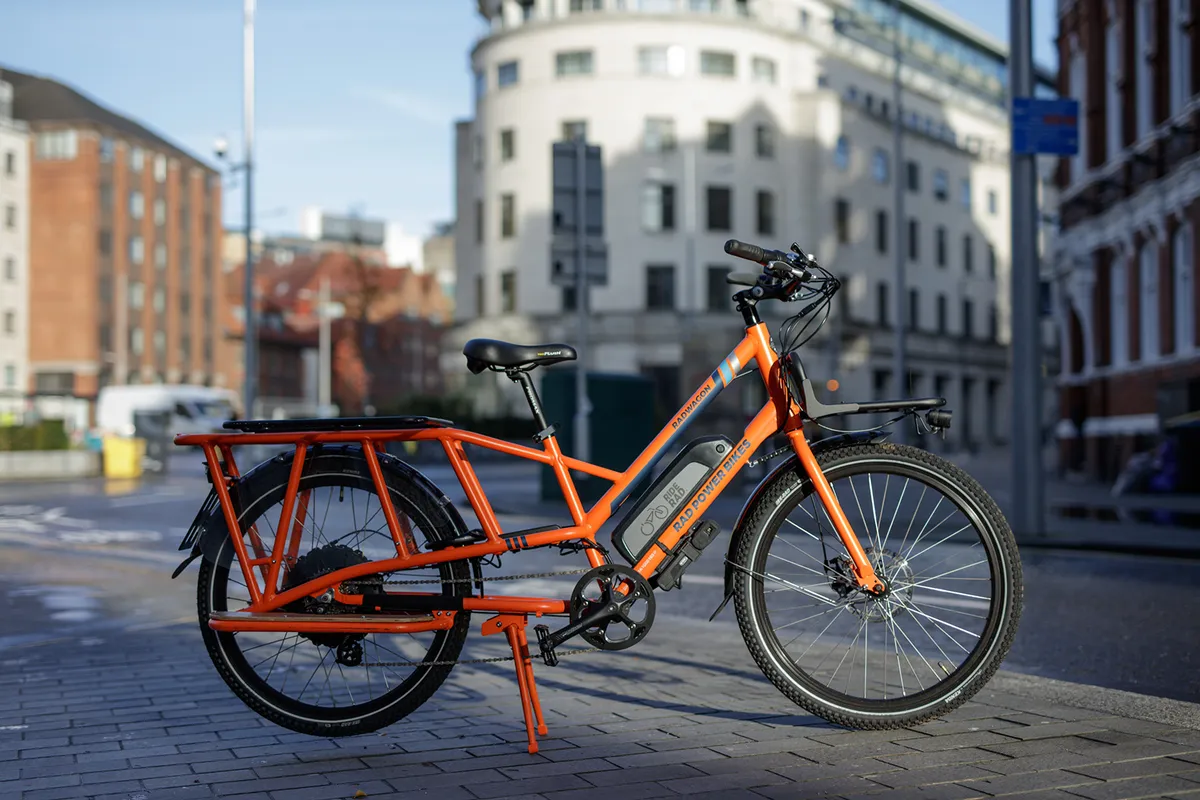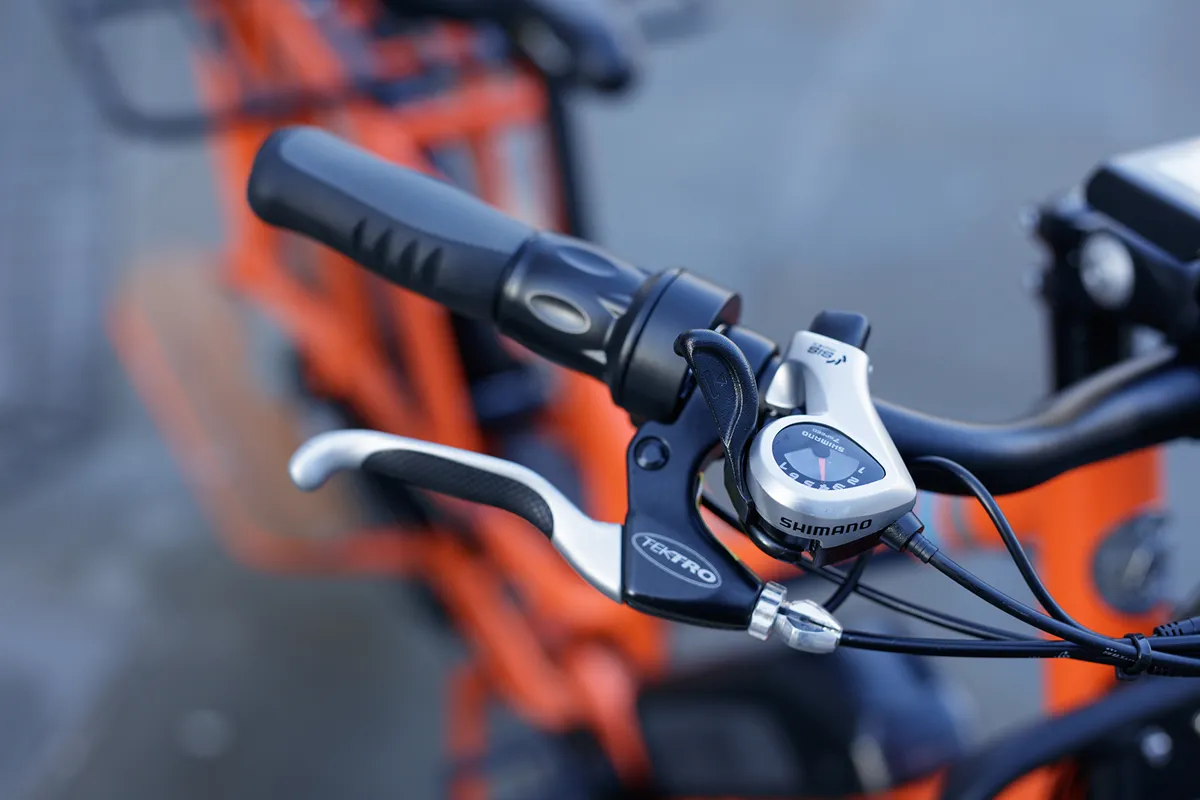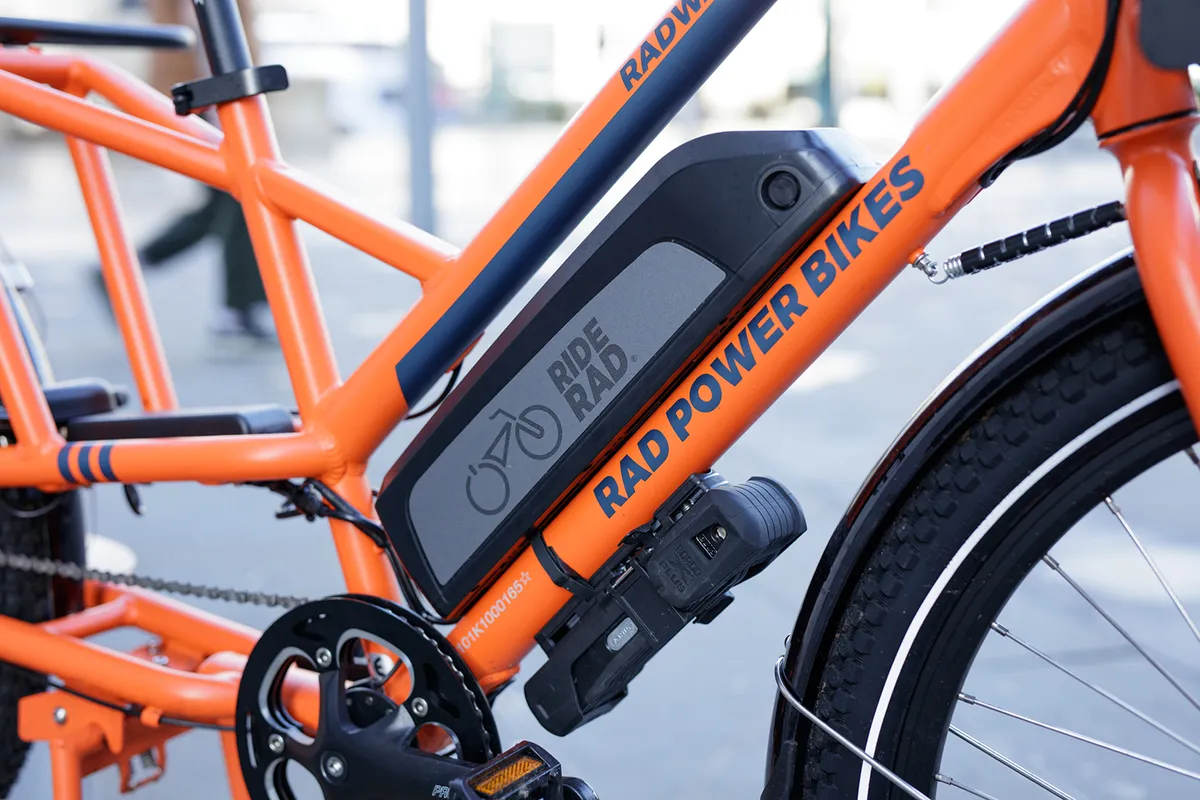- The Surly Big Draggler might just be the fastest cargo bike out there
- LIFT turns nearly any bike into a cargo bike
Rad Power Bike’s RadWagon cargo bike has a highly modular design to allow you to carry a wide range of loads, from big boxes to your kids. Despite its adaptability, it’s one of the cheapest electric cargo bikes on the market.
With urban centres becoming increasingly congested, and with the current ‘Climate Crisis’ an ever-growing source of concern, cargo bikes, electric or otherwise, could, and should, prove to be part of the solution.
The addition of a motor extends their capabilities and means they’re accessible to more people, whether that be thanks to local (hilly) geography, mobility or fitness issues, or simply because there’s a lot of items that need carrying.
The legal bit
The first thing to clarify is that the RadWagon isn’t a ‘normal’ electric bike because its motor and inclusion of a throttle exclude it from regular ‘e-bike’ legislation. It is classed as a L1e-A electric bicycle, which allows a throttle for auxiliary propulsion with the primary aim to aid pedalling.
Its assistance should still be limited to 25kph, and its maximum continuous rated power should not exceed 1,000W.
The RadWagon features brake lights to supplement the always-on front light, as well as an instant cut in the motor's power as soon as the brakes are applied.
L1e-A bikes should be registered and appropriately insured – but this will be dependent on where you live.
So, assuming this has all been done, we’ll now consider this as we would any other bike review.
Rad Power RadWagon details and specifications
Rad Power RadWagon frame
The front half of the aluminium bike is fairly regular, with a low-slung top tube to aid getting on and off the bike, especially when loaded up with weight. The bars sit high out in front, contributing to a comfortable forward-looking position on the bike.
The rear half of the bike is more interesting; its chainstays are 673mm long, so a good 25cm longer than many other (non-cargo) bikes, which helps give plenty of real estate for the rear cargo rack.
As discussed later, the rear section has a number of potential set-ups, with various racks and running boards available to suit your needs. The standard build has a regular width wooden board running along the top of the frame rack, with a pair of wood-topped running boards located towards the rear, just below the height of the rear derailleur.
Rad Power says that the rear rack has a 54kg weight limit, each running board 18kg and the kickstand, located behind the bottom bracket, 45kg.
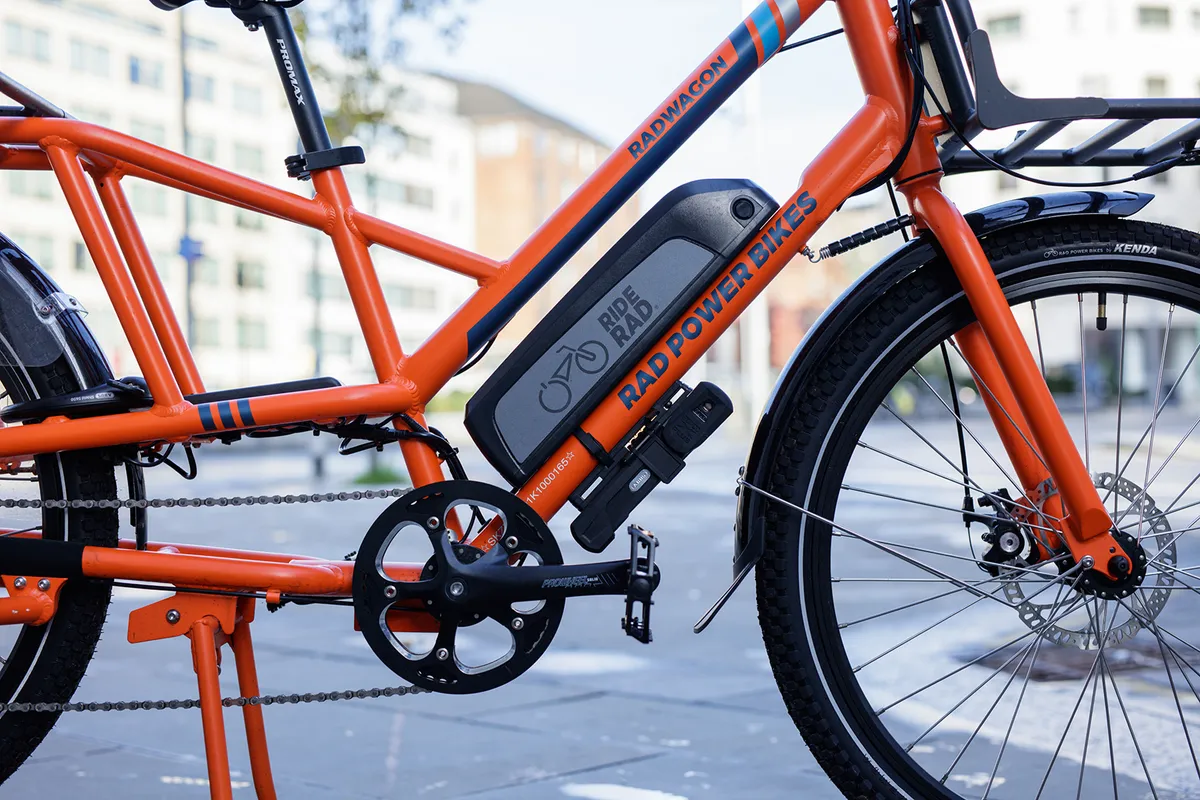
Cables all route externally, there’s a threaded bottom bracket shell and a small spring connecting front triangle to fork crown to prevent the front wheel flopping around when the bike is on its spring-loaded kickstand – as the wheel turns, the spring is extended, so unloaded, the wheel will return to centre. While riding, the spring has no noticeable effect on handling.
Rad Power RadWagon motor
Rad Power uses a Shengyi direct-drive hub motor on the RadWagon, which has 750W of power. This is supplied by a 672Wh battery, located within the front triangle.
On the bars there’s an LCD screen showing plenty of detail, which is backlit when the front and rear lights are illuminated (the front light is always on, the rear light and screen back light can be turned on). It shows speed, distance, power being delivered and which of the five power modes the bike is currently in.
Next to the left-hand grip is the on/off button, and the buttons that toggle between power modes. The whole system can be secured with a key located by the battery – lock it and the system can’t start up. I left it turned to ‘on’ all of the time which allows the system to be turned on or off with the switch by the grip.
Charging the bike takes around six hours, so I tended to leave it charging overnight.
As mentioned, the RadWagon has a throttle. This is a twist-grip style unit on the right-hand side of the handlebars. Twisting the throttle provides power to the rear wheel and the level of power is determined by the mode the system is in. There is a supplementary button next to the throttle, which is there to turn the throttle on and off, however, at times we've found it varying in how effective it is.
Rad Power RadWagon kit
The bike comes with a 7-speed single-ring drivetrain, with Shimano’s Acera groupset providing the bulk of the kit. There’s an 11-34t cassette which, while not massive in range, tended to cover all bases when travelling around Bristol, thanks in part to the motor's assistance. A 42t chainring drives the bike and is built on to 170mm cranks.
The shifter’s levers are located on top of the shifter, so the ergonomics are different to your usual flat-bar shifter.

The brakes are cable disc units from Tektro, with 180mm rotors front and rear. The levers for these clamp on to a Dutch-style moustache bar, with grips that have a palm-shaped extension.
The stem is highly adjustable and with only one frame size, this should allow a wider range of riders to fit on the bike. The saddle is a bulky unit and I’d change it for long rides, but for short hops across town it’s functional.
The bike rolls on 26in wheels that are constructed with 36 spokes and shod with Kenda K-Rad tyres, which were built specifically for Rad Power. These have a grid-like tread, which provided fine traction on tarmacked surfaces.
Rad Power RadWagon accessories
On top of the rack and running boards that come with the bike, which sit slightly lower than regular chainstays, there are a wide range of accessories to fit straight on to the bike.
These include various (metal tubing) baskets, bags and panniers, and range in price, but on the face of it don’t look quite as good value as the bike. Although they could vastly improve the usability of the bike, depending on what you want the bike for.
When ordering the test bike, I requested a Front Rack (€69), Large Platform (€39), Fremont Pannier (€59) and Abus Bordo Granit X-plus 6500 lock (€89).
Rad Power RadWagon performance
Rad Power RadWagon motor
I feel that your initial impression of the RadWagon will depend a lot on whether you’ve ridden e-bikes before, or not, and that’s because of the bike’s motor.
In essence, the hub-based motor doesn’t have the slick reactivity of a Bosch or Shimano unit, with a noticeable lag in power delivery to the bike when you pedal before the motor provides assistance. Without the throttle, this makes those initial pedal strokes harder work and should you stop pedalling while negotiating tight turns, it doesn’t leap to your assistance once you start pedalling again.
For this reason, the throttle becomes immediately handy. During testing I used the throttle almost exclusively to start the bike moving, rather than coasting along on the throttle. It makes getting away from lights with any load a lot easier than it would be otherwise.
However, it’s worth remembering that pulling on the brake lever (that is connected electronically to the motor) instantly cuts the motor, and can induce an error if you try to twist the throttle while you’ve got the brake levers pulled.

The throttle has a secondary button, but I never quite figured out how it worked – sometimes I needed to press the button for the throttle to work, sometimes not. I’m sure there's a logic to it, but after four months of testing, I still haven’t quite worked it out.
In summary, the throttle is very, very handy on this bike, thanks to the un-reactivity of the pedal assistance from the motor. I very rarely felt the need to use the throttle while cruising along, but it is perfectly possible to, however I see it more as an initial acceleration aid, rather than an excuse to stop pedalling.
The next point about the motor is that despite the headline 750W power, it doesn’t ‘feel’ like it has three times the power of a normal e-bike motor. I think this is because its torque figures probably aren’t quite so impressive.
I never felt the bike was under-powered by any stretch, and the assistance it provides is pretty good, but don’t expect motorbike levels of acceleration. With the heaviest loads I carried, or on steeper inclines at low speed, there wasn’t masses of assistance, so I really had to add the power via my legs.
Rad Power RadWagon carrying capacity
With a lot of bike comes a substantial carrying capacity, both in terms of weight and the size of items one can carry. The Large Platform has been mounted on the rear, giving a broad surface area onto which items can be strapped. The strutted frame design means there are plenty of places bungee cords can be clipped on to the rack, to ensure a secure hold on the item, but I found that the diameter of the tubes is just a little broader than the internal diameter of hooks on my bungee cords – a small frustration.
The bike’s frame itself also has plenty of struts and tubes onto which straps and bungees can be strapped. So, aslong as you have the right lengths of strap/bungee, and you’re not being overly ambitious, you should be able to attach what you need to the bike (taking care of side-to-side balance points, etc).
The front rack hasn’t been quite as useful as I’d imagined because in front of the bars is a nest of cables: gear, brake, motor. This means anything that rises up more than 20cm or so pushes on the cables. It’s not un-useful, but I’ve not used it as much as I thought I would.

The running boards have also proved handy from a carrying point of view, on the odd occasion I’ve had something slim but tall to carry – think bicycle wheel size. The running boards are removable, however their usefulness has meant they’ve remained in place.
The flip-side of all this carrying capacity is that the length and width overall makes the bike trickier to live with than others. Locking it to bike racks (especially if you can’t get an end-rack) is tricky, and storing it is limited to garages with wide entrances – you’d be lucky to get it through a door, and if you had to do so frequently would quickly become a chore.
With the Large Platform removed life becomes easier, but the length and weight still make many bike racks and storage areas a frustration. All said, though, the number of tubes available means there’s loads of locking point options, as well as a place to grab if you need to lug the bike around – backed up by the handle on the back of the saddle.
The centrally mounted kickstand has been very handy. It’s spring loaded, so just rocking the bike forwards leaves the stand to rotate up and out of the way. It’s broad enough to give reasonable balance with luggage on the bike. When stood on the stand, the bike balances very close to its balance point, so only a little extra weight on the front, or back, of the bike will cause it to flip from resting on the stand and front or rear wheel.
While I have no children, the RadWagon has numerous attachments to take smaller passengers on trips: handles, foam rack covers and the running boards. I have, it has to be said, given a friend a slightly drunken lift home from the pub, and he reported that the ride was much better than walking. While unfair to comment too much on this experience, it did highlight the importance of potentially adjusting tyre pressures for your luggage.
With a considerably heavier load than usual on the bike, the tyres could have done with more than the 40psi I had in them and they squirmed around, as would be expected. So, this is no criticism, but a point of interest because it’s rare on a ‘normal’ bike that load weight would need much consideration.
As yet I have not had any issues with battery life or performance. There’s enough capacity to make plenty of inner-city trips, and I tend to top up the battery every 40km or so (rarely have I run it close to flat). Unlike e-MTBs, I feel the general useage of this bike would be less likely to push the bike to its battery limits in a single ride.
Given that this bike is used as a mode of transport, rather than a way to get more exercise (my normal bike riding does a good enough job there!), I have used the bike exclusively in its most powerful mode. It has enough range to do so, given the generally short nature of the trips, so it makes sense to use all the available power.
It’s easy to pick faults with such a unique bike, but it is also important to bear in mind that it is incredibly useful, and it is some of this usefulness that makes more menial tasks a pain.
By removing carrying capacity, you’d make it easier to live with, but that would also diminish its usefulness.
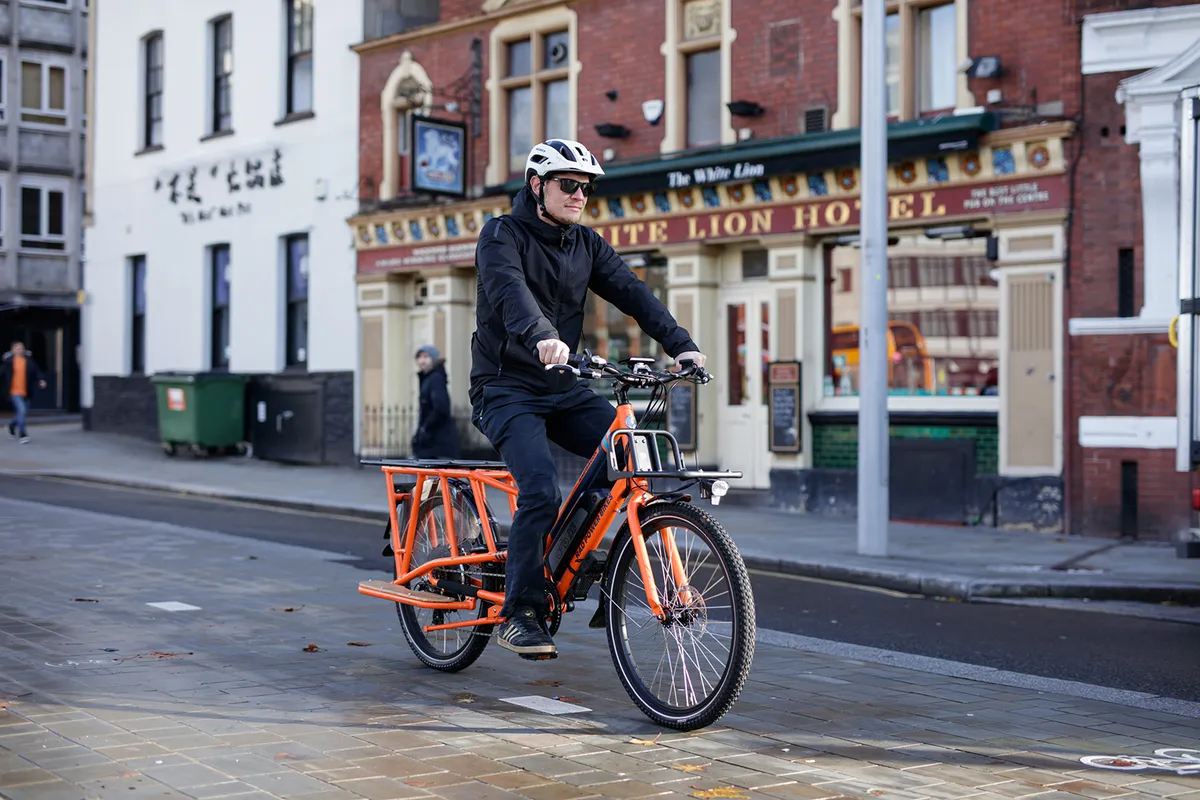
It is also worth noting just how ‘cheap’ the bike is compared to its competitors, whether that be boutique cargo bike brands such as Reise and Müller, or companies such as Kona and Surly who have the Electric Ute and Big Easy respectively. While these may have an arguably better, more torquey motor, they are also considerably more expensive.
Finally, a word on e-cargo bikes as a concept. In short, I’m sold. They make travelling around a city a far easier, less stressful option than driving, or lugging a non-powered bike around.
Sure, there’s less ‘exercise’ than there would be on a normal bike, but I believe that these bikes should be seen as a quicker, more convenient alternative to the car. They are simply a mode of transport, not a vehicle for exercise.
Product
| Brand | Radpower |
| Price | €1699.00 |
Features
| Fork | Steel |
| Stem | Zoom, 60 degree adjustment |
| Chain | KMC Z7 Rustbuster |
| Frame | Aluminium |
| Motor | 750W Brushless Shengyi Direct Drive Hub Motor with 40Nm of Torque |
| Tyres | Kenda K-Rad 26in x 2.3in, K-Shield puncture-resistant liner |
| Brakes | Tektro Aries, 180mm rotors |
| Cranks | ProWheel Pioneer Forged Alloy, Dual-Sided Aluminum Bashguard, 170mm, 42t |
| Saddle | Velo Plush with handle |
| Wheels | 36 Hole Alloy |
| Headset | Semi-integrated |
| Shifter | Shimano SL-TX50-7R thumb shifter |
| Cassette | DNP 7spd, 11-34 |
| Seatpost | Alloy |
| Handlebar | Aluminum Alloy |
| Bottom bracket | Square taper |
| Available sizes | One Size |
| Rear derailleur | Shimano Altus 7spd |
| Features | Lights Front: Spanninga PR60 48V with Ambient Light Sensor Option Lights Rear: Integrated Taillight with Brake Light Indicator Functionality Charger: 48V 2 Amp Smart Charger, Operates on 230V AC Power Outlets Display: Backlit LCD with Charge Indicator, Speedometer and more |

